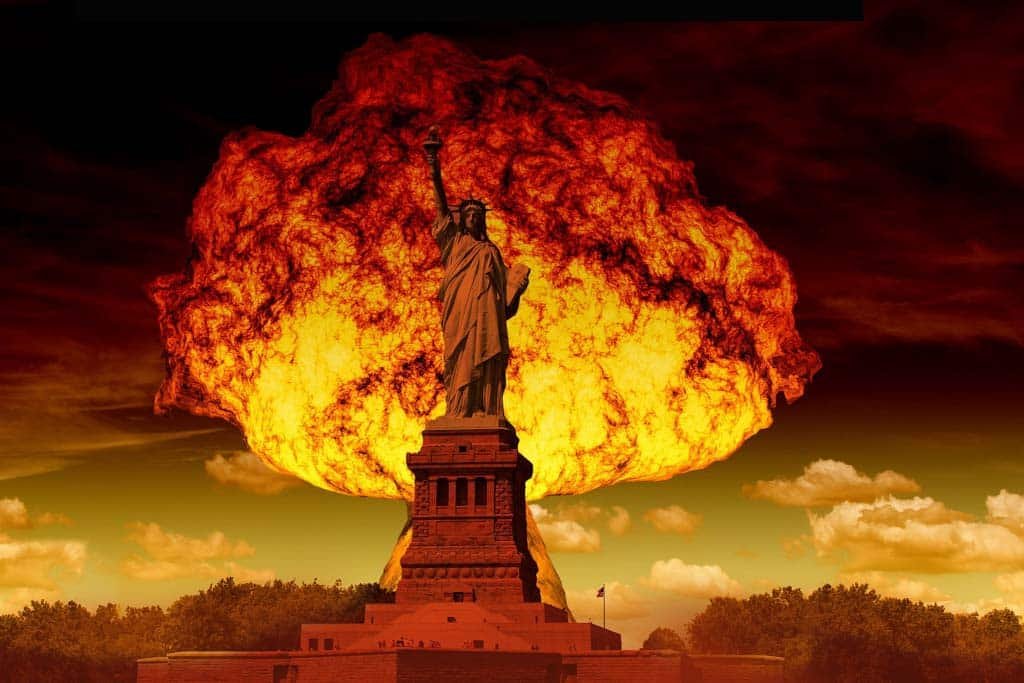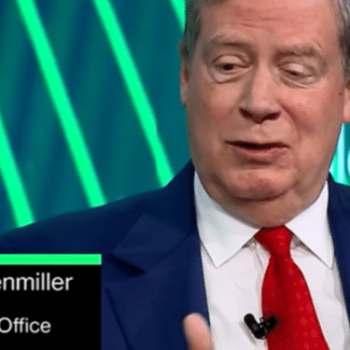
In early 2015, I received a telephone call from Pulitzer Prize-winning journalist Jo Becker. She was working on a front-page article for the New York Times.
Jo was researching the uranium market and the Clinton family. Specifically, she was looking into how one Russian-controlled company came to own some U.S.-based uranium mines… and what role, if any, Bill and Hillary Clinton had played in the story.
I spent over an hour walking Jo through the uranium market. I explained how the U.S. got 20% of its electricity at the time from uranium-fueled nuclear power, yet produced less than 10% of its annual needs domestically. It made up its vast supply shortfall mostly by importing uranium from Russia or Russian-influenced countries. This made the U.S. energy supply vulnerable to the dangerous geopolitical chess master Vladimir Putin.
Becker’s article blew the lid off a scandal that has plagued the Clintons for years now. The mainstream media’s general story goes like this: Uranium is a strategic resource the U.S. should safeguard at all costs. Yet, in 2010, the Russian company in question, Rosatom, was able to purchase and control strategic U.S. uranium mines (through a company called Uranium One). Bill and Hillary Clinton helped Rosatom’s backers pull off the deal because they made massive donations to the Clinton Foundation. The press called it “pay to play.”
The idea that Bill and Hillary Clinton sold out America’s strategic interests harmed Hillary Clinton’s 2016 presidential campaign. I’m sure the Clintons hoped that the damage stopped right there. Yet over the past few weeks, the story has been given new life. In today’s rabid U.S. political climate, Clinton enemies want to see corruption charges filed.
Yet again, the Clinton/Uranium deal has become a huge front-page story. It’s all over the big talk shows. And that’s why once again, I have reporters from big-name media companies calling and emailing me to talk about uranium and the Clintons.
I have quite a bit of experience with reporters. While there are some very good journalists out there (Jo Becker being one of them), I’ve never been satisfied with their efforts to accurately quote me or explain the full stories as I see them. Many other folks I know who have given interviews feel the same.
So, rather than talk to a reporter who will filter it through their own mind and write their own version of how I see things, I’m going to personally share with you the “inside story” as I see it. Here are some big things the mainstream media has wrong about Clintons, uranium, and corruption.
One: The uranium project the Russians acquired – Willow Creek – isn’t anything special.
It’s not a critical part of the U.S. uranium supply. It’s absolutely not key to U.S. “strategic interests.” In 2016, Willow Creek produced 100,000 pounds of uranium. This represented just 3.64%% of total U.S. production of 2.7 million pounds.
Willow Creek currently has 16.9 million pounds of uranium reserves and resources. This is just 1.14% of total U.S. uranium reserves and resources.
At current uranium prices, Willow Creek isn’t even economical. The uranium price is down 55% since the Uranium One deal. In fact, since the deal was done for Willow Creek, the Russians have cut production at the mine by over 50%. In 2011, Willow Creek produced 214,000 pounds of uranium. The Russians ramped production to over 900,000 pounds in 2013, only to cut back production every year for the next three years.
The massive price decline makes Willow Creek a losing investment. The Russians would love to sell the project and focus on their bigger, better assets. However, by selling now in the currently depressed uranium market, they’d take a huge loss. My hunch is that the Russians are holding the asset in hopes the uranium market will get stronger. Then, they will sell it.
I’m not making a political statement by pointing out this fact. It’s just something anyone with any knowledge about the uranium market knows. Nobody sold out a key part of the U.S. uranium supply to the Russians at a discount. They just sold a small, unimportant, relatively high-cost uranium mine at a huge premium to its current value.
Two: The real reason the Russians bought Uranium One was for its exceptional assets in Kazakhstan.
Most citizens only know the central Asian nation of Kazakhstan by the hit 2006 movie Borat. The title character is a caricature of a Kazakh television reporter. What most people don’t know is that Kazakhstan has become a huge player in one of the world’s most important energy markets.
In 2016, the world got 40% of its uranium from Kazakhstan. Put another way, Kazakhstan is four times more important to the global nuclear market than Saudi Arabia is to the global oil market. Kazakhstan is more important to the uranium sector than the world’s five largest oil producers (Russia, Saudi Arabia, U.S., China, and Canada) are to the oil sector combined.
Twenty years ago, Kazakhstan produced virtually no uranium. Fast forward to today and it’s now the world’s largest producer. It’s one of the fastest ascents to the top of a resource market’s food chain in modern history.
Kazakhstan took the uranium heavyweight title of the world thanks to a production method called “in situ recovery,” or ISR, which by the way was invented and perfect in the 1960’s in the U.S.
All of Kazakhstan’s uranium production comes from ISR. It’s the cheapest way to produce uranium. This is because ISR involves no blasting, digging, hauling, or crushing of rock. It involves no conventional open pit mine or underground mines.
ISR pumps the equivalent of soda water into porous rock that hosts elevated uranium concentrates. The water becomes “impregnated” with uranium and is then pumped out of the rock. An ISR operation is more like a water processing facility than a mine.
Kazakhstan has the lowest uranium production costs in the world. That is why Rosatom purchased Uranium One, not to get control of a small, relatively-high cost mine in the U.S.
I love a good conspiracy theory. Some theories actually turn out to be true. However, any claim that the Russians bought Willow Creek in a sneaky attempt to control the U.S. power supply is just nuts. Russia’s decision to buy Uranium One was simply a matter of money. It was a matter of owning some of the world’s best uranium assets.
Three: Russia didn’t need to buy Willow Creek to get the U.S. over a barrel. It already had that.
To most people, Russian President Vladimir Putin is a movie-quality villain. He’s a former KGB officer. He meddles in presidential elections. People that speak out against him tend to disappear.
That’s why most Americans would be astonished and angry to learn how U.S political leaders have put America in a vulnerable situation… and dependent on Russian uranium to keep its lights on.
Remember, as I noted, the U.S. generates 20% of its electricity from nuclear power. It consumes about 50 million pounds of uranium each year. Yet, it gets less than 7% of its supply from domestic U.S. uranium mine production.
The U.S. gets almost twice as much uranium from strategic Department of Energy stockpiles as its gets from total U.S. uranium mine production. It also gets a little uranium from Canada and a little from Australia. But the U.S. gets the bulk of its uranium (more than 50%) from unfriendly Russia and former USSR states that are heavily influenced by Russia.
This puts the U.S. in a dangerous situation. Over the past decade, Russia and the United States have gotten into a variety of low-level disagreements. If a disagreement were to escalate, Vladimir Putin could easily “play the uranium card” and cut off Russian uranium supplies to the United States. Putin could also exert influence over Kazakhstan and block uranium shipments to the U.S. This would cause an American power crisis.
The U.S. cannot rely on big producers like Canada and Australia for uranium imports. Neither country can supply enough uranium to fulfill American demand. More importantly, both Canada and Australia have signed long-term agreements with India and China. This means there is even less uranium available for U.S. imports.
Also, raw, physical uranium is of no use to nuclear power producers. It must be refined or “enriched” to a specific grade to be of use. This refinement process is extremely expensive, extremely difficult, and extremely time-consuming. In the uranium market, enrichment capacity is even more important than raw, physical uranium supply.
Russia controls over 50% of the world’s uranium enrichment capacity.
The enrichment facilities in the U.S. and in countries friendly to the U.S. are running virtually flat out.
A trillion pounds of uranium could magically appear in the U.S., and couldn’t be used to produce power because the U.S. doesn’t possess or have access to the needed enrichment capacity. Building this capacity would take more than 10 years and tens of billions of dollars.
The U.S. cannot simply “flip a switch” and get its electricity from other power sources like dirty coal, solar, wind, or natural gas. It does not have the infrastructure to do so. Building it would take a decade.
The U.S. has painted itself into a corner. It must have nuclear energy or the lights will go out.
This mishandling of America’s energy supply has given Russian President Vladimir Putin an incredible amount of leverage over America. Just imagine if the U.S. depended on Russia for more than 50% of its crude oil needs. People would be protesting in Washington D.C.
The U.S. has just one possible path forward in the short term if it wants to keep the lights on for the equivalent of two Californias. It will have to pay tens of billions of dollars to secure enriched uranium from Russian-controlled sources… at prices much higher than the current spot price or long-term price.
As for the long-term, the U.S. must encourage a massive expansion in domestic mine supply and enrichment capacity. This includes “fast-tracking” the permitting process for new mines and enrichment facilities.
Over the past ten years, the U.S. made amazing advancements in domestic oil production by encouraging shale oil projects. It needs to do the same with uranium.
It’s literally in the interest of U.S. national security to take these steps. (If you happen to know anyone with any say in the U.S. government, please forward them this piece.)
Again, American citizens would be protesting in the streets if they were heavily dependent on Russian-controlled oil to power their cars. They should be equally concerned about being so dependent on Russian-controlled uranium for much of their electricity needs.
There is a perfect setup here for a well-funded, intelligent U.S. uranium management team to consolidate the broken U.S. uranium sector. The nuclear sector, including the uranium exploration, development, and production segment of the sector has been crushed. But the fact is, nuclear power is here to stay. The U.S. will continue to demand 50 million pounds of uranium for decades to come. More importantly, there will be a U.S. uranium first agenda playing out in the sector. Meaning that there will be political and economic support to create jobs in the U.S. uranium sector.
Three decades ago, over 25,000 direct jobs were in the uranium sector in the U.S. Today, there are less than 500. Not even the coal sector, which has seen its market share of electricity generation drop by 50% in the U.S over the last decade, has seen such a large percentage drop in employment.
If you are a value-focused contrarian investor and you have the testicular fortitude and patience to make an “unpopular” trade that has the potential to make incredible gains in the future, you should look into the uranium sector.
I can’t speak to what the Clintons did or did not do in the Uranium One deal. We all know politics is a dirty business. I don’t have a political dog in the fight. But to me, the real scandal is how over the past years, U.S. government officials allowed themselves to be played like a fiddle by Vladimir Putin.
They’ve handed him more control over the U.S. power supply than he ever should have had. They tossed him a free trump card. It’s just a matter of time before he plays it.
Regards,
Marin
PS. A small, elite group of Katusa readers just made a 63% capital gain OVERNIGHT. Two more huge potential wins are shaping up right now. Don’t miss out on tomorrow’s next huge resource score. Learn how to get in right here.






